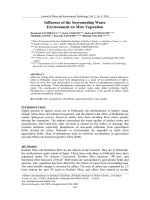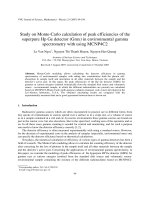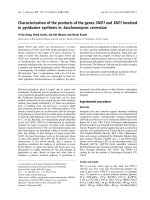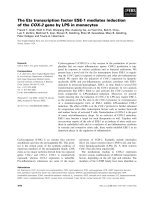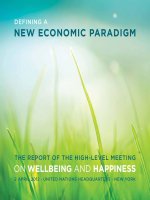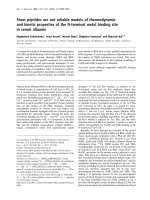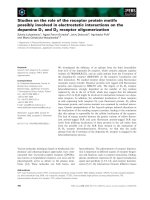Habituation of the startle reflex depends on attention in cannabis users
Bạn đang xem bản rút gọn của tài liệu. Xem và tải ngay bản đầy đủ của tài liệu tại đây (636.17 KB, 8 trang )
Kedzior et al. BMC Psychology (2016) 4:50
DOI 10.1186/s40359-016-0158-8
RESEARCH ARTICLE
Open Access
Habituation of the startle reflex depends
on attention in cannabis users
Karina K. Kedzior1,2,3*, Eileen Wehmann2 and Mathew Martin-Iverson3
Abstract
Background: Cannabis use is associated with an attention-dependent deficit in prepulse inhibition of the startle
reflex (PPI). The aim of the current study was to investigate startle habituation in cannabis users and healthy
controls during two attentional tasks.
Methods: Auditory startle reflex was recorded from orbicularis oculi muscle while participants (12 controls and 16
regular cannabis users) were either attending to or ignoring 100 dB startling pulses. Startle habituation was
measured as the absolute reduction in startle magnitude on block 2 (last nine trials) vs. block 1 (first nine trials).
Results: Startle habituation with moderate effect sizes was observed in controls and cannabis users only while they
were ignoring the startling pulses but not while they were attending to them. Similar results were also observed in
controls (lifetime non-users of cannabis) and cannabis users with lifetime cannabis use disorders (CUD).
Conclusion: Startle habituation appears to depend on selective attention but not on cannabis use. Startle
habituation was present when attention was directed away from auditory startling pulses in healthy controls
and cannabis users. Such a similar pattern of results in both groups suggests that at least a trend exists
towards presence of startle habituation regardless of cannabis use or CUD in otherwise healthy members
of the general population.
Keywords: Startle habituation, Cannabis misuse, Selective attention
Background
The relationship between cannabis use and mental
health has been studied extensively. Empirical data show
that particularly heavy cannabis use is positively related
to affective outcomes, including major depression [1]
and anxiety disorders [2]. While the magnitude of these
relationships remains small for affective outcomes [3],
there exists a more consistent and stable association
between cannabis use and psychotic outcomes [4]. It has
been shown that early onset and heavy cannabis use is
related to earlier onset and higher odds for psychosis
and is especially prevalent in younger, male, first-episode
patients with schizophrenia [5–8].
Regardless of such extensive research, the physiological
bases of the relationship between cannabis use and
* Correspondence:
1
Institute of Psychology and Transfer, University of Bremen, (FB 11), Grazer
Str. 2c, 28359 Bremen, Germany
2
School of Engineering and Science, Jacobs University Bremen, Bremen,
Germany
Full list of author information is available at the end of the article
psychotic outcomes remain largely unknown. One candidate for studying such physiological bases is the process of
sensorimotor gating which is thought to indirectly measure the allocation of cognitive resources to appropriately
filter the sensory stimuli [9]. Sensorimotor gating can be
quantified as prepulse inhibition (PPI) of the startle reflex
[10]. Startle reflex is a contraction of the skeletal and facial
muscles in response to a sudden, relatively intense stimulus (startling pulse) in any sensory modality [11]. PPI is a
reduction in startle magnitude which occurs when a lowintensity stimulus (prepulse) is presented 30–500 ms before the startling pulse [12]. Apart from prepulses, startle
magnitude can be modified by selective attention [13].
Furthermore, in the absence of prepulses, startle magnitude habituates (is reduced) over time after repetitive
presentation of startling pulses [14].
Sensorimotor gating appears to be affected by psychosis and cannabis use. In general, schizophrenia studies
have shown that, relative to healthy controls, PPI deficit
was observed either during passive (no task) paradigms
© The Author(s). 2016 Open Access This article is distributed under the terms of the Creative Commons Attribution 4.0
International License ( which permits unrestricted use, distribution, and
reproduction in any medium, provided you give appropriate credit to the original author(s) and the source, provide a link to
the Creative Commons license, and indicate if changes were made. The Creative Commons Public Domain Dedication waiver
( applies to the data made available in this article, unless otherwise stated.
Kedzior et al. BMC Psychology (2016) 4:50
[15] or during selective attention paradigms depending
on attentional demand ([13, 16], for review see [17]). In
addition, participants with cannabis-induced psychotic
disorder showed PPI deficits but only at very short
prepulse-pulse intervals relative to healthy controls [18].
PPI was also reduced in participants at high risk for
psychosis with urinary cannabinoids relative to healthy
controls [9]. In contrast, studies of cannabis users without psychosis reported less consistent PPI deficits. During passive attention paradigms adult cannabis users and
non-user controls showed similar levels of PPI [19],
while adolescent cannabis users failed to maintain PPI
over time compared to controls [20]. The evidence from
studies with selective attention paradigms suggests that
PPI deficit occurred only while cannabis users attended
to, but not ignored, auditory pulses relative to controls
[21, 22]. Interestingly, studies directly comparing cannabis users and schizophrenia patients showed that PPI
deficits were similar in both groups relative to controls.
Specifically, PPI deficit was reported in both cannabis
users and in (non-user) schizophrenia patients while
attending to, but not ignoring, pulses and prepulses
during various attentional tasks [23, 24].
Unlike PPI, another aspect of startle modification,
namely startle habituation, received less research attention, particularly in cannabis users. Habituation refers to
a reduction in behavioral response following repeated
stimulation and does not involve sensory or motor
fatigue [25]. Startle habituation is often quantified as a
reduction in startle magnitude on blocks of trials towards the end compared to the beginning of the experiment. In schizophrenia research startle habituation has
been used to explore information processing and attentional deficits associated with this disorder [26]. Unlike
PPI deficits, only some schizophrenia studies reported a
deficit (or a trend towards a deficit) in startle habituation during passive attention paradigms (for example,
[14, 27–35]) while others did not find such a deficit (for
example, [36–38]). Such inconsistent results are not
surprising given the heterogeneous methods of quantifying startle habituation [39]. It is also unclear if and
how startle habituation is altered by cannabis use. The
evidence from passive attention paradigms showed that
both controls and cannabis users (healthy or at high
risk for psychosis) displayed similar patterns of startle
habituation in terms of reduction in startle magnitude
on later relative to earlier trials [9, 19, 20]. To our
knowledge startle habituation has not been studied
during selective attention paradigms in cannabis users,
although similarly to PPI, startle habituation might depend on attention. Attentional processing is particularly
affected in heavier and longer-term cannabis users [40].
Thus, if startle habituation depends on attention, it
might be especially affected by heavier cannabis use.
Page 2 of 8
Although neither PPI nor startle habituation can be used
as physiological markers of psychosis or cannabis use, it is
important to study these indirect measures of brain function to develop effective therapies against psychiatric
disorders [10] and to understand the physiological bases
of the relationship between cannabis use and psychosis.
The aim of the current study was to investigate startle
habituation in cannabis users relative to healthy controls
during two selective attention tasks involving either attending to or ignoring auditory pulses. The second aim
was to investigate startle habituation in heavier cannabis
users (users with lifetime cannabis use disorders, CUD)
relative to healthy controls. It was hypothesized that, similarly to attention-related PPI deficits, startle habituation
might be impaired in cannabis users relative to controls
but only while attending to pulses and not when ignoring
them [21]. It was also expected that, if cannabis use affects
attention [40], any deficit in startle habituation would be
particularly evident in heavier cannabis users with lifetime
CUD relative to healthy controls.
Methods
The current methods have already been described in
detail elsewhere [21, 23]. The data reported in this study
have not been published before. The study was approved
by the research ethics committees at the University of
Western Australia and Graylands Hospital, Perth, Australia,
and all participants gave a written informed consent to take
part in the study.
Participants
Participant recruitment procedure, exclusion criteria,
and demographic characteristics of both groups are
shown elsewhere [21, 23]. Briefly, following the exclusion
of participants positive for other substances in urine
and/or with symptoms of psychiatric disorders the sample consisted of 12 healthy controls and 16 cannabis
users recruited from the general population of Perth,
Australia. All controls were non-users of cannabis in the
last 12 months. The majority of cannabis users (81 %;
13/16) were daily-weekly users in the last 12 months, 69 %
(11/16) reported lifetime symptoms of CUD, and 75 %
(12/16) reported recent (24 h) use and were positive for
cannabinoids in urine [21].
Cannabis use and CUD diagnoses
Cannabis use was defined as at least one-time use of
cannabis (in any form, concentration, or duration) in the
last 12 months since the testing session. Self-reports
regarding the recent use of cannabis (within 24 h) were
validated with urine screens and were found to be accurate in the current participants [41]. Lifetime diagnoses
of CUD (cannabis dependence and/or abuse) were established based on DSM-IV and/or ICD-10 criteria using
Kedzior et al. BMC Psychology (2016) 4:50
the Composite International Diagnostic Interview (CIDIAuto 2.1) [42]. The presence of CUD diagnoses on
CIDI-Auto 2.1 was accurately predicted using scores on
the lifetime Severity of (Cannabis) Dependence Scale,
SDS [43], in the current participants [44]. Although it
cannot be ruled out, it was assumed that our participants had little motivation to misreport their substance
use based on the high agreements among self-reports of
recent use and urine screens, among lifetime CUD
diagnoses and SDS scores, as well as the full anonymity
and strict confidentiality of the study [41, 44]. Since
withdrawal from other substances (such as caffeine) can
affect startle habituation [45], all participants were required to maintain their usual cannabis consumption (if
users) and to refrain from nicotine for at least 1 h before
testing and alcohol on the day of testing.
Startle procedure
The auditory startle reflex was measured during two
attentional tasks. The current study focuses on 36 pulsealone trials only (18 per attentional task). During the
Attend Task the participants were asked to passively
listen to the background white noise (60 dB) interrupted
by 18 pulses at 100 dB (white noise; duration 50 ms,
nearly instantaneous rise/fall time) presented binaurally
via headphones. During the Ignore Task the participants
were told to ignore the auditory stimuli and play a handheld Tetris-like computer game. The order of attentional
tasks (Attend – Ignore or Ignore – Attend) was counterbalanced within each group.
Data acquisition and processing
A detailed description of data acquisition and processing
can be found elsewhere [21]. The startle reflex was
acquired as electromyogram (EMG) from the left orbicularis oculi muscle. The magnitude of the startle reflex
was measured as the area under the peak curve (μV) to
take into account both the magnitude and the duration
of startle response.
Page 3 of 8
drinks per week in the last 12 months). Covariates were
used because, relative to controls, cannabis users reported
significantly higher nicotine and alcohol consumption in
the last 12 months [21]. ANCOVA was followed up with
pairwise comparisons corrected for family-wise error
using Bonferroni’s adjustment. The effect sizes for pairwise comparisons were computed using the standardized
mean difference, Hedges’ g, for paired or independent
means [46]. The interpretation criteria for the absolute
size of Hedges’ g are: .20–.49 (small effect), .50–.79 (moderate effect), and ≥ .80 (large effect) [46].
Results
Participant characteristics: controls vs. cannabis users
The two groups (controls and cannabis users) were
matched on demographic characteristics (gender, handedness, age, IQ, education) and caffeine use [21] while,
relative to controls, cannabis users reported significantly
higher nicotine and alcohol consumption in the last 12
months [21].
Startle habituation: controls vs. cannabis users
According to aim 1 of the current study, startle habituation was investigated in cannabis users relative to
controls during two attentional tasks. The results of
ANCOVA are shown in Table 1.
Group
The main effect of GROUP was not statistically significant
(Table 1). The difference in mean startle magnitudes
adjusted for nicotine and alcohol use was negligible
between controls and cannabis users (g = .08) (Fig. 1a).
Table 1 Startle habituation in controls vs. cannabis users
MS
df
F
ptwo-tailed
Power
.04
.844
.05
Between subject-effect
GROUP (G)
44686.22
1
Error
1136543.52
24
Within subject-effects
Data analysis
BLOCK (B)
1867751.11
1
10.07
.004*
The mean startle magnitudes were computed for each
participant on the first half (block 1 with nine trials) and
the second half of the experiment (block 2 with nine
trials) using IBM-SPSS 22.0. Startle habituation was
measured as the absolute difference in the mean startle
magnitude between block 1 and block 2 on each attentional task and in each group. Group means were compared using the repeated measures analysis of covariance
(ANCOVA) with two within-subject factors (ATTENTION with two levels: Attend vs. Ignore Tasks; BLOCK
with two levels: 1 vs. 2), one between-subject factor
(GROUP with two levels: controls vs. cannabis users),
and two covariates (cigarettes per day and alcoholic
B×G
14118.78
1
.08
.785
Error
185411.16
24
.06
ATTENTION (A)
11425152.19
1
22.88
<.001*
A×G
1432.61
1
.003
.958
.05
Error
499442.31
24
Interactions
B×A
12044.68
1
.12
.737
.06
B×A×G
3554.59
1
.03
.855
.05
Error
104706.22
24
Note. Effect sizes are reported in text and on figures
Abbreviations: df degrees of freedom, MS mean square
*p < .05
Kedzior et al. BMC Psychology (2016) 4:50
Page 4 of 8
Fig. 1 Mean startle magnitudes adjusted for nicotine and alcohol use depending on a group (controls vs. cannabis users), b block
(1 vs. 2), c attention (Attend vs. Ignore Tasks), and d group, block, and attention. All p-values were adjusted using Bonferroni’s correction.
Abbreviations: B1, Block 1; B2, Block 2; g, standardized mean difference (Hedges’ g; effect size); N, sample size; SEM, standard error of
the mean
Habituation
There was a statistically significant main effect of
BLOCK (Table 1). The inspection of means adjusted
for nicotine and alcohol use revealed that startle habituation occurred because startle magnitudes were
significantly reduced on block 2 relative to block 1
(Fig. 1b). The effect size of startle habituation was
only moderate (g = .60; Fig. 1b).
Attentional modulation
There was a statistically significant main effect of ATTENTION (Table 1). The inspection of means adjusted
for nicotine and alcohol use revealed that startle magnitudes were significantly reduced on the Ignore Task
relative to the Attend Task (Fig. 1c). The effect size of
attentional modulation of startle magnitudes was large
(g = 1.13; Fig. 1c).
Habituation by group and attention
A similar pattern of startle habituation was observed
in controls and cannabis users. Pairwise comparisons
revealed that startle habituation depends on attention
in both groups (Fig. 1d). Startle habituation with moderate effect sizes was observed only on the Ignore Task
in controls (g = .63) and in cannabis users (g = .71;
Fig. 1d). In contrast, startle habituation on the Attend
Task had only small effect sizes (g = .27–.39) in both
groups (Fig. 1d).
Participant characteristics: controls (lifetime non-users of
cannabis) vs. cannabis users with CUD
Demographic characteristics of controls (lifetime nonusers of cannabis) and cannabis users with lifetime CUD)
are shown in Table 2. Both groups were matched on all
characteristics except for nicotine and alcohol consumption in the last 12 months which were significantly higher
in cannabis users relative to controls (Table 2).
Startle habituation: controls vs. cannabis users with CUD
According to aim 2 of the current study, startle habituation was investigated in cannabis users with lifetime
CUD relative to controls (lifetime non-users of cannabis)
during two attentional tasks. The results of ANCOVA
are shown in Table 3.
The same pattern of responses as in the previous
analysis was seen in controls (lifetime non-users of
cannabis) and cannabis users with lifetime CUD. Specifically, startle magnitudes were similar in both groups
(Fig. 2a). Startle habituation (with moderate effect size;
Fig. 2b) and attentional modulation (with large effect
size; Fig. 2c) occurred in both groups. Finally, startle
habituation with moderate effect sizes was observed on
the Ignore Task in both groups (Fig. 2d).
Discussion
The current study shows that habituation of the acoustic
startle reflex depends on selective attention but not on
cannabis use or CUD in otherwise healthy samples from
Kedzior et al. BMC Psychology (2016) 4:50
Page 5 of 8
Table 2 Participant characteristics depending on lifetime CUD (dependence/abuse)
χ2 (df)
ptwo-tailed
8/3
.42 (1)
.518
9/2
.27 (1)
.605
Demographics
Controls no CUD
Cannabis users with CUD
N
7
11
Male/Female
6/1
Right/Left-handed
5/2
M ± SD (range)
M ± SD (range)
t (df )
ptwo-tailed
Age (years)
34 ± 9 (18–43)
29 ± 8 (19–44)
1.23 (16)
.238
IQ
104 ± 10 (86–115)
103 ± 10 (79–117)
.25 (16)
.809
Education (years)
13 ± 2 (10–14)
13 ± 2 (9–17)
-.64 (16)
.531
Alcohol/week (last 12 months)
3 ± 3 (0–10)
10 ± 8 (0–24)
−2.53 (15)
.023*
Cigarettes/day (last 12 months)
0 ± 0 (0–.1)
3 ± 1 (0–10)
−2.42 (10)
.036*
.56 (16)
.586
Coffee cup/day (last 12 months)
4 ± 1 (0–15)
2 ± 1 (0–10)
Duration of use (years)
-
13 ± 8 (2–27)
Age of first use (years)
-
16 ± 3 (13–21)
Last use (hours before testing)
-
9 ± 5 (2–13)
Urine cannabinoids (μg/l)
-
692 ± 910 (0–2000)
SDS score
-
4 ± 2 (0–7)
Note. All controls were lifetime non-users of cannabis
Abbreviations: CUD lifetime cannabis use disorder, df degrees of freedom, SDS Severity of (Cannabis) Dependence Scale (15 indicates maximum dependence
on cannabis)
*p < .05
the general population. Although the statistical power
to detect group differences was low based on small
group sizes, the pattern and magnitude of startle responses were remarkably similar between healthy controls and cannabis users in our study (using selective
attention paradigms) and also in other, uninstructed,
studies [9, 19, 20]. It appears that startle habituation
Table 3 Startle habituation in controls vs. cannabis users with
lifetime CUD
MS
df
F
ptwo-tailed
Power
.10
.759
.06
Between subject-effect
GROUP (G)
90864.23
1
Error
929419.40
14
BLOCK (B)
1176010.10
1
4.65
.049*
B×G
49900.05
1
.20
.664
Error
253131.49
14
Within subject-effects
.07
ATTENTION (A)
6957742.99
1
10.08
.007*
A×G
56530.51
1
.08
.779
.06
Error
690499.01
14
B×A
27816.59
1
.21
.652
.07
B×A×G
45835.97
1
.35
.564
.09
Error
131125.25
14
Interactions
Note. All controls were lifetime non-users of cannabis. Effect sizes are
sreported in text and on figures. For abbreviations refer to Tables 1 and 2
*p < .05
occurs in the absence of a specific attentional instruction
in controls and cannabis users (some with CUD and in
those at risk for psychosis) [9, 19, 20] or only when attention is directed away from pulses during a selective attention paradigm (current study). Therefore, unlike PPI,
startle habituation may not be affected by any level of
cannabis use. Specifically, startle habituation occurred in
heavier users of cannabis using six days per week [20] and
four days per week [19], following cannabis abstinence for
18 h to three days [19, 20], in users with urine positive for
cannabinoids (our study, [9, 20]), and in users with lifetime CUD (our study and [20]). On the other hand, a high
degree of heterogeneity in definition of cannabis use
among all studies above might have masked any deficits in
startle habituation. Future research with larger samples is
necessary to assess startle habituation depending on the
acute vs. long-term use and in reliably and validly classified low-level vs. heavy cannabis users.
Interestingly, startle habituation was present when
participants ignored the auditory pulses and startle responses were similar in magnitude in controls, cannabis
users, as well as in a pilot sample of non-users of cannabis with schizophrenia (data for latter not shown). Since
the same pilot sample of schizophrenia patients and the
same cannabis users showed a significant reduction in
PPI when attending to pulses relative to controls [23],
a trend towards an intact startle habituation in all
three groups indicates that different neural processes
might underlie startle habituation and PPI. In general,
unlike the influence of attention on PPI, it seems that
Kedzior et al. BMC Psychology (2016) 4:50
Page 6 of 8
Fig. 2 Mean startle magnitudes adjusted for nicotine and alcohol use and depending on a group (controls: lifetime non-users of cannabis vs.
cannabis users with CUD), b block (1 vs. 2), c attention (Attend vs. Ignore Tasks), and d group, block, and attention. All p-values were adjusted
using Bonferroni’s correction. Abbreviations: B1, Block 1; B2, Block 2; CUD, cannabis use disorder; g, standardized mean difference (Hedges’ g;
effect size); N, sample size; SEM, standard error of the mean
a minimal processing of pulses required while attention is being directed away from them, was necessary
for startle habituation to occur in our study and also
in another study using healthy participants [47].
The current results confirm that the startle reflex is
modulated by selective attention in healthy controls and
also in cannabis users. Both groups showed consistently
reduced startle responses when attention was directed
away from pulses compared to attending to pulses. A
similar pattern of attentional modulation of startle magnitudes was shown in another study with healthy participants on the Visual Attention Task (equivalent to our
Ignore Task) compared to the No Attention Task (passive
attention equivalent to our Attend Task) and Auditory
Attention Task (active attention) [47]. Intact attentional
modulation of startle habituation in cannabis users is
surprising considering that cannabis use affects selective
attention [40]. Therefore, on the one hand, the attentional
deficit associated with cannabis consumption might depend on a difficulty of an attentional task and be less
severe than the attentional deficit observed in schizophrenia [23]. On the other hand, any impairments in selective
attention might depend on factors, such as acute intoxication or the frequency/total duration of cannabis use [48]
rather than on any level of cannabis use and/or presence
of CUD (as in the current study). Therefore, future studies
should investigate startle habituation during selective attention tasks taking into account task difficulty, acute
intoxication, and heaviness of cannabis use.
There were a number of limitations in the current
study. First, the statistical power to detect group differences was low due to only small sample sizes. Thus, the
current results should be interpreted with caution and
may not be generalisable to a wider population of cannabis users. Interestingly, the remarkably similar pattern of
results (in terms of the effect sizes) suggests that at least
a trend exists towards presence of startle habituation
regardless of cannabis use. Second, as most other studies
in this area, the current study was not specifically designed to focus on startle habituation. Our startle paradigm included pulse-alone and prepulse-and-pulse
trials (excluded from the current analysis). Thus, startle
habituation was inspected in blocks of pulse-alone trials
rather than individual trials because of our complex
study design (both attentional tasks started with different trials). We also included more trials per block than
most other studies. An additional analysis using a threeblock design produced similar results (not shown) to the
results reported here. Thus, it is unlikely that a higher
number of blocks with fewer trials would substantially
alter our results. A study designed to best quantify startle habituation has shown that, similarly to trials included in our analysis, startle habituation occurred on
trials 2–13 using 100 dB pulses [39]. Third, we have
not controlled for the personality traits or the general
cognitive performance. Although startle habituation
was not related to the former in healthy controls [49],
personality characteristics affected habituation rate in
Kedzior et al. BMC Psychology (2016) 4:50
healthy participants [50]. Fourth, due to very low startle
responses (mean peak magnitudes <10 μV) on all trials
23 % of all participants (N = 7 controls and N = 5
cannabis users) were classified as non-responders and
were excluded from the study. The non-response rate
probably resulted from deficiencies in detecting the
EMG signal using skin-surface electrodes rather than
from group membership because non-responders were
found in both groups. Therefore, the electrode resistance should be measured prior to data collection to
improve the quality of recording and reduce the nonresponse rate. Finally, although it cannot be ruled out,
it is unlikely that acute cannabis use and presence of
cannabinoids in urine affected the current results.
There were no trends towards any associations between
urine cannabinoids and startle habituation according to
bivariate correlations (results not shown). However,
future studies should investigate the impact of acute
use of cannabis on startle habituation in larger samples.
Conclusion
In summary, startle habituation appears to depend on
selective attention but not on cannabis use or CUD.
Startle habituation was present when attention was directed away from auditory startling pulses in healthy
controls and cannabis users. Such similar pattern of
results in both groups suggests that at least a trend
exists towards presence of startle habituation regardless
of cannabis use. The current results should be replicated
in larger samples of cannabis users taking into account
the effects of acute exposure as well as heaviness and
duration of use. Since startle habituation occurs when
attention is drawn away from rather than directed towards the startling stimuli, researchers should control
for any differences in attention between groups when
studying startle habituation.
Abbreviations
CUD: Cannabis use disorder; PPI: Prepulse inhibition of the startle reflex
Acknowledgements
We thank Professor Johanna Badcock (University of Western Australia) and
Professor Helen Stain (University of Newcastle, Australia) for assistance with
clinical testing.
Funding
This research was funded by The Western Australian Foundation for Research
into Schizophrenic Disorders and the NHMRC (grant no. 254619 awarded to
MMI). The funding bodies were not involved in study design, collection,
analysis, and interpretation of data, writing of the manuscript or the decision
to submit the manuscript for publication.
Availability of data and material
All data are available upon request from the first author. The individual
participant data are not available publicly since we did not seek the ethical
permission to share such data (participants consented to publication of their
data as part of a group only).
Page 7 of 8
Authors’ contributions
KKK and MMI designed the study, KKK and EW analyzed the data, all authors
contributed to writing of the manuscript. All authors read and approved the
final manuscript.
Competing interests
The authors declare that they have no competing interests.
Consent for publication
Non-applicable.
Ethics approval and consent to participate
The study was approved by the research ethics committees at the University
of Western Australia and Graylands Hospital, Perth, Australia, and all
participants gave a written informed consent to take part in the study.
Author details
1
Institute of Psychology and Transfer, University of Bremen, (FB 11), Grazer
Str. 2c, 28359 Bremen, Germany. 2School of Engineering and Science, Jacobs
University Bremen, Bremen, Germany. 3Clinical Neurophysiology Unit,
Graylands Hospital and Pharmacology & Anaesthesiology Unit, School of
Medicine & Pharmacology, Faculty of Medicine, Dentistry & Health Sciences,
The University of Western Australia, Perth, Australia.
Received: 14 July 2016 Accepted: 17 October 2016
References
1. Lev-Ran S, Roerecke M, Le Foll B, George TP, McKenzie K, Rehm J. The
association between cannabis use and depression: a systematic review and
meta-analysis of longitudinal studies. Psychol Med. 2014;44:797–810.
2. Kedzior K, Laeber L. A positive association between anxiety disorders and
cannabis use or cannabis use disorders in the general population- a
meta-analysis of 31 studies. BMC Psychiatry. 2014;14:136.
3. Kedzior KK, Gerkensmeier I, Lüdders L, Hofmann L, Engelhardt T-C. What do
we know about the relationship between cannabis use and depression or
anxiety in the general population? A summary of results from systematic
reviews. Paper presented at the 50th Conference of the German Society for
Psychology (DGPs). 2016.
4. Minozzi S, Davoli M, Bargagli AM, Amato L, Vecchi S, Perucci CA. An
overview of systematic reviews on cannabis and psychosis: discussing
apparently conflicting results. Drug Alcohol Rev. 2010;29:304–17.
5. Degenhardt L, Hall WD, Lynskey M, McGrath J, McLaren J, Calabria B,
Whiteford H, Vos T. Should burden of disease estimates include cannabis
use as a risk factor for psychosis? PLoS Med. 2009;6:29.
6. Koskinen J, Lohonen J, Koponen H, Isohanni M, Miettunen J. Rate of
cannabis use disorders in clinical samples of patients with schizophrenia: a
meta-analysis. Schizophr Bull. 2010;36:1115–30.
7. Large M, Sharma S, Compton MT, Slade T, Nielssen O. Cannabis use and
earlier onset of psychosis: a systematic meta-analysis. Arch Gen Psychiatry.
2011;68:555–61.
8. Semple D, McIntosh A, Lawrie S. Cannabis as a risk factor for psychosis:
systematic review. J Psychopharmacol. 2005;19:187–94.
9. Winton-Brown T, Kumari V, Windler F, Moscoso A, Stone J, Kapur S, McGuire
P. Sensorimotor gating, cannabis use and the risk of psychosis. Schizophr
Res. 2015;164:21–7.
10. Swerdlow NR, Braff DL, Geyer MA. Sensorimotor gating of the startle reflex:
what we said 25 years ago, what has happened since then, and what
comes next. J Psychopharmacol. 2016. doi:10.1177/0269881116661075.
11. Braff DL, Geyer MA, Swerdlow NR. Human studies of prepulse inhibition of
startle: normal subjects, patient groups, pharmacological studies.
Psychopharmacology (Berl). 2001;156:234–58.
12. Graham F. The more or less startling effects of weak prestimulation.
Psychophysiology. 1975;12:238–48.
13. Dawson M, Hazlett E, Filion D, Nuechterlein K, Schell A. Attention and
schizophrenia: impaired modulation of the startle reflex. J Abnorm Psychol.
1993;102:633–41.
14. Geyer M, Braff D. Habituation of the blink reflex in normals and
schizophrenic patients. Psychophysiology. 1982;19:1–6.
15. Braff D, Stone C, Callaway E, Geyer M, Glick I, Bali L. Prestimulus effects on human
startle reflex in normals and schizophrenics. Psychophysiology. 1978;15:339–43.
Kedzior et al. BMC Psychology (2016) 4:50
16. Scholes KE, Martin-Iverson MT. Disturbed prepulse inhibition in patients with
schizophrenia is consequential to dysfunction of selective attention.
Psychophysiology. 2010;47:223–35.
17. Swerdlow N, Weber M, Qu Y, Light G, Braff D. Realistic expectations of
prepulse inhibition in translational models for schizophrenia research.
Psychopharmacology (Berl). 2008;199:331–88.
18. Morales-Munoz I, Jurado-Barba R, Ponce G, Martinez-Gras I, Jimenez-Arriero
MA, Moratti S, Rubio G. Characterizing cannabis-induced psychosis: a study
with prepulse inhibition of the startle reflex. Psychiat Res. 2014;220:535–40.
19. Quednow BB, Kuhn KU, Hoenig K, Maier W, Wagner M. Prepulse inhibition and
habituation of acoustic startle response in male MDMA ('ecstasy') users, cannabis
users, and healthy controls. Neuropsychopharmacology. 2004;29:982–90.
20. Mathias C, Blumenthal T, Dawes M, Liguori A, Richard D, Bray B, Tong W,
Dougherty D. Failure to sustain prepulse inhibition in adolescent marijuana
users. Drug Alcohol Depend. 2011;116:110–6.
21. Kedzior K, Martin-Iverson M. Chronic cannabis use is associated with
attention-modulated reduction in prepulse inhibition of the startle reflex in
healthy humans. J Psychopharmacol. 2006;20:471–84.
22. Scholes KE, Martin-Iverson MT. Alterations to pre-pulse inhibition (PPI) in
chronic cannabis users are secondary to sustained attention deficits.
Psychopharmacology (Berl). 2009;207:469–84.
23. Kedzior K, Martin-Iverson M. Attention-dependent reduction in prepulse
inhibition of the startle reflex in cannabis users and schizophrenia patientsa pilot study. Eur J Pharmacol. 2007;560:176–82.
24. Scholes-Balog KE, Martin-Iverson MT. Cannabis use and sensorimotor gating
in patients with schizophrenia and healthy controls. Hum Psychopharm
Clin. 2011;26:373–85.
25. Rankin CH, Abrams T, Barry RJ, Bhatnagar S, Clayton DF, Colombo J,
Coppola G, Geyer MA, Glanzman DL, Marsland S, McSweeney FK, Wilson DA,
Wu CF, Thompson RF. Habituation revisited: an updated and revised
description of the behavioral characteristics of habituation. Neurobiol Learn
Mem. 2009;92:135–8.
26. Geyer M, Swerdlow N, Mansbach R, Braff D. Startle response models of
sensorimotor gating and habituation deficits in schizophrenia. Brain Res
Bull. 1990;25:485–98.
27. Akdag S, Nestor P, O'Donnell B, Niznikiewicz M, Shenton M, McCarley R. The
startle reflex in schizophrenia: Habituation and personality correlates.
Schizophr Res. 2003;64:165–73.
28. Bolino F, Manna V, Di Cicco L, Di Michele V, Daneluzzo E, Rossi A,
Cassacchia M. Startle reflex habituation in functional psychoses: a controlled
study. Neurosci Lett. 1992;145:126–8.
29. Braff D, Grillon C, Geyer M. Gating and habituation of the startle reflex in
schizophrenic patients. Arch Gen Psychiatry. 1992;49:206–15.
30. Hammer TB, Oranje B, Fagerlund B, Bro H, Glenthoj BY. Stability of prepulse
inhibition and habituation of the startle reflex in schizophrenia: a 6-year
follow-up study of initially antipsychotic-naive, first-episode schizophrenia
patients. Int J Neuropsychoph. 2011;14:913–25.
31. Ludewig K, Geyer M, Etzensberger M, Vollenweider F. Stability of the
acoustic startle reflex, prepulse inhibition, and habituation in schizophrenia.
Schizophr Res. 2002;55:129–37.
32. Ludewig K, Geyer M, Vollenweider F. Deficits in prepulse inhibition and
habituation in never-medicated, first-episode schizophrenia. Biol Psychiatry.
2003;54:121–8.
33. Meincke U, Light G, Geyer M, Braff D, Gouzoulis-Mayfrank E. Sensitization
and habituation of the acoustic startle reflex in patients with schizophrenia.
Psychiat Res. 2004;126:51–61.
34. Parwani A, Duncan E, Bartlett E, Madonick S, Efferen T, Rajan R,
Sanfilipo M, Chappell P, Chakravorty S, Gonzenbach S, Ko G, Rotrosen
J. Impaired prepulse inhibition of acoustic startle in schizophrenia. Biol
Psychiatry. 2000;47:662–9.
35. Taiminen T, Jaaskelainen S, Ilonen T, Meyer H, Karlsson H, Lauerma H,
Leinonen KM, Wallenius E, Kaljonen A, Salokangas RK. Habituation of the
blink reflex in first-episode schizophrenia, psychotic depression and
non-psychotic depression. Schizophr Res. 2000;44:69–79.
36. Braff D, Swerdlow N, Geyer M. Symptom correlates of prepulse
inhibition deficits in male schizophrenic patients. Am J Psychiatry.
1999;156:596–602.
37. Quednow BB, Wagner M, Westheide J, Beckmann K, Bliesener N, Maier W,
Kuehn K-U. Sensorimotor gating and habituation of the startle response in
schizophrenic patients randomly treated with amisulpride or olanzapine.
Biol Psychiatry. 2006;59:536–45.
Page 8 of 8
38. Quednow BB, Frommann I, Berning J, Kühn K-U, Maier W, Wagner M.
Impaired sensorimotor gating of the acoustic startle response in the
prodrome of schizophrenia. Biol Psychiatry. 2008;64:766–73.
39. Lane ST, Franklin JC, Curran PJ. Clarifying the nature of startle habituation
using latent curve modeling. Int J Psychophysiol. 2013;88:55–63.
40. Solowij N, Michie PT. Cannabis and cognitive dysfunction: Parallels with
endophenotypes of schizophrenia? J Psychiatr Neurosci. 2007;32:30–52.
41. Kedzior K, Badcock J, Martin-Iverson M. Validity and consistency of
self-reports regarding substance use in general research volunteers,
including regular cannabis users and schizophrenia patients. Subst Use
Misuse. 2006;41:743–50.
42. World Health Organization. Composite International Diagnostic Interview
(CIDI), version 2.1. Geneva: World Health Organisation; 1997.
43. Gossop M, Darke S, Griffiths P, Hando J, Powis B, Hall W, Strang J. The
Severity of Dependence Scale (SDS): psychometric properties of the SDS in
English and Australian samples of heroin, cocaine and amphetamine users.
Addiction. 1995;90:607–14.
44. Kedzior K, Martin-Iverson M. Concurrent validity of cannabis misuse
diagnoses on CIDI-Auto 2.1 in low-level cannabis users from the general
population. Aust J Psychol. 2007;59:169–75.
45. Swerdlow N, Eastvold A, Gerbranda T, Uyan K, Hartman P, Doan Q,
Auerbach P. Effects of caffeine on sensorimotor gating of the startle reflex
in normal control subjects: impact of caffeine intake and withdrawal.
Psychopharmacology (Berl). 2000;151:368–78.
46. Borenstein M, Hedges L, Higgins J, Rothstein H. Introduction to meta-analysis.
Great Britain: John Wiley & Sons, Ltd; 2009.
47. Schicatano E, Blumenthal T. The effects of caffeine and directed attention
on acoustic startle habituation. Pharmacol Biochem Behav. 1998;59:145–50.
48. Solowij N, Michie P, Fox A. Differential impairments of selective attention due
to frequency and duration of cannabis use. Biol Psychiatry. 1995;37:731–9.
49. Hasenkamp W, Kelley M, Egan G, Green A, Wilcox L, Boshoven W, Lewison B,
Duncan E. Lack of relationship between acoustic startle and cognitive variables
in schizophrenia and control subjects. Psychiat Res. 2011;187:324–8.
50. Blanch A, Balada F, Aluja A. Habituation in acoustic startle reflex: Individual
differences in personality. Int J Psychophysiol. 2014;91:232–9.
Submit your next manuscript to BioMed Central
and we will help you at every step:
• We accept pre-submission inquiries
• Our selector tool helps you to find the most relevant journal
• We provide round the clock customer support
• Convenient online submission
• Thorough peer review
• Inclusion in PubMed and all major indexing services
• Maximum visibility for your research
Submit your manuscript at
www.biomedcentral.com/submit

